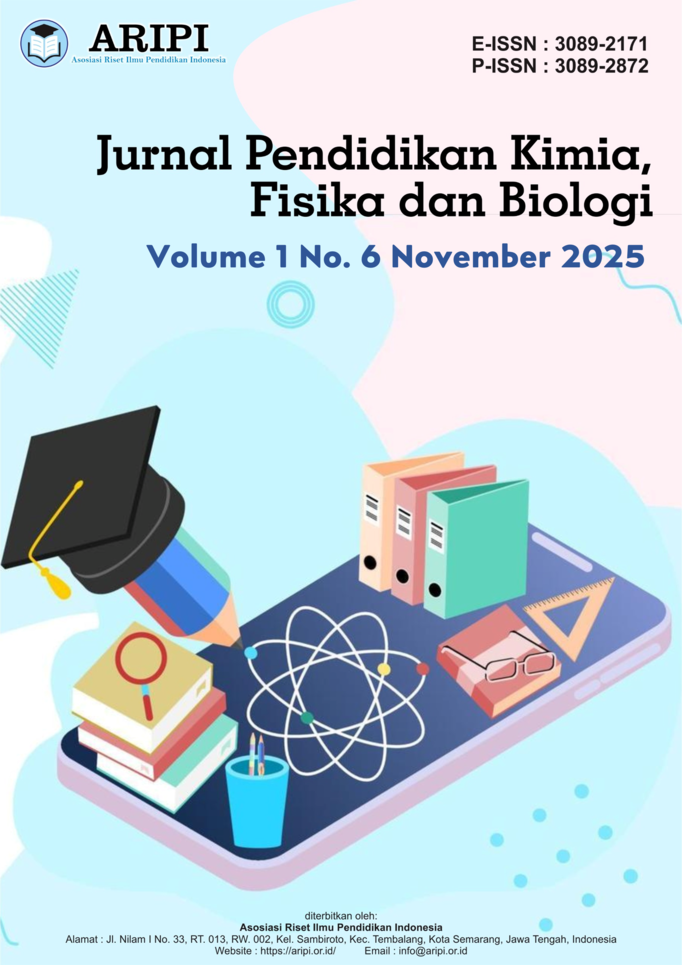Efek Suhu Aktivasi terhadap Struktur Mikro Material Karbon Aktif Pelepah Enceng Gondok untuk Aplikasi Elektroda Superkapasitor
DOI:
https://doi.org/10.61132/jupenkifb.v1i6.686Keywords:
Activated Carbon, FTIR, Functional Groups, Supercapacitor Electrode, Water HyacinthAbstract
Supercapacitor electrode material bassed on Pelepah Enceng Gondok Activated Carbon (KAPEG have been developed for increasing the performance of the supercapacitor application. The activated carbon surface structure and its properties strongly depend on the pyrolysis temperature and the type of activation methods. The bamboo carbon has been fabricated using pyrolysis method. The KAPEG was produced using chemical activation with H3PO4 as activation agent with variation of temperature activation 750oc have been carried out. Characterization of the surface structure (functional groups vibration) of bamboo carbon (CB) pyrolysis and the Pelepah enceng Gonddok activated carbon (KAPEG) were carried out using FTIR. The aim of this research is to identify the functional groups vibration. he FTIR rssults shows absorption peeaks of functional groups of -OH, C=O, C-O, C-H and C-C vibration. The increasing of wavenumber of absorption peaks of functional groups -OH stretching, C=O stretching and C-H indicate that the functional groups bond for KAPEG samples becomes more stronger than for KPEG sample. The conclusion of this research are: the increasing of wavenumber of absorption peaks for functional groups indicates of more stronger of functional groups bond.
References
Arunkumar, M., & Amit, P. (2017). Importance of electrode preparation methodologies in supercapacitor applications. Journal of the American Chemical Society, 1(2), 8039–8050. https://doi.org/10.1021/acsomega.7b01275
Arunkumar, M., & Paul, A. (2017). Importance of electrode preparation methodologies in supercapacitor applications. ACS Omega, 2(11), 8039–8050. https://doi.org/10.1021/acsomega.7b01275
Asnawi, R., Nurhadiyanto, D., Arifin, Z., & Asmara, A. (2018). The characteristic of supercapacitors circuit as a future electrical energy storage media. Journal of Physics: Conference Series, 1140(1), 012001. https://doi.org/10.1088/1742-6596/1140/1/012001
Eko, N., Erman, T., & Rakhmawati, F. (2015). Pembuatan dan karakterisasi sel superkapasitor menggunakan karbon aktif monolit dari kayu karet berdasarkan variasi konsentrasi HNO₃. Jurnal Material FMIPA, 2(1), 49–55.
Farly, R., & Septiany, C. (2018). Pemanfaatan karbon aktif dari sabut kelapa sebagai elektroda superkapasitor. Fullerene Journal of Chemical, 3(1), 13–18. https://doi.org/10.37033/fjc.v3i1.29
Fitriana, V. (2014). Sintesis dan karakterisasi superkapasitor berbasis nanokomposit TiO₂/C [Skripsi, Universitas Negeri Malang]. Universitas Negeri Malang.
Heindrich, T., et al. (2022). Pembuatan superkapasitor sebagai devais penyimpanan energi listrik PLTS Unima dan SPKLU supercharging.
Hussain, O. A., Hathout, A. S., Abdel-Mobdy, Y. E., Rashed, M. M., Abdel Rahim, E. A., & Fouzy, A. S. M. (2023). Preparation and characterization of activated carbon from agricultural wastes and their ability to remove chlorpyrifos from water. Toxicology Reports, 10, 146–154. https://doi.org/10.1016/j.toxrep.2023.01.011
Kadir, M., & Arof, A. (2011). Application of PVA–chitosan blend polymer electrolyte membrane in electrical double layer capacitor. Materials Research Innovations, 15(2), 217–220. https://doi.org/10.1179/143307511X13031890749299
Ki, Q., & John, W. (2016). Graphene-based materials for supercapacitor electrodes: A review. Journal of Materomics, 2(1), 37–54. https://doi.org/10.1016/j.jmat.2016.01.001
Lewandowski, M., & Orzylowski, M. (2017). Fractional order model: The case study of the supercapacitor capacitance measurement. Bulletin of the Polish Academy of Sciences and Technical Sciences. https://doi.org/10.1515/bpasts-2017-0050
Lokhande, C. D., Dubal, D. P., & Joo, O.-S. (2011). Metal oxide thin film-based supercapacitors. Current Applied Physics, 11(3), 255–270. https://doi.org/10.1016/j.cap.2010.12.001
Rima, Suastikaa, M., & Sirait, R. (2022). Pengaruh suhu aktivasi fisika terhadap uji mikrostruktur karbon aktif mangrove. ATTDRIB Journal, 6(2). https://doi.org/10.54069/attdrib.v6i2.558
Sitohang, I. A. (2020). Pembuatan dan pengujian elektroda superkapasitor berbasis graphene dengan metode charging-discharging [Tesis, Universitas Sumatera Utara]. Program Studi Magister Fisika, FMIPA Universitas Sumatera Utara.
Suherman, M., Hasanah, R., Ariandi, & Ilmi. (2021). Pengaruh suhu pemanasan terhadap karakteristik dan mikrostruktur karbon aktif pelepah kelapa sawit. Jurnal Industri Hasil Perkebunan, 16(1), 1–9.
Umar, A. A., Rahman, M. Y. A., Taslim, R., & Salleh, M. M. (2011). Dye-sensitized solar cell utilizing quasi one-dimensional of highly compact vertical array ZnO nanorod. International Journal of Electrochemical Science, 7, 7253–7260. https://doi.org/10.1016/S1452-3981(23)15781-6
Wang, J., Gao, Z., Li, Z., Wang, B., Yan, Y., Liu, Q., Mann, T., Zhang, M., & Jiang, Z. (2011). Green synthesis of graphene nanosheets/ZnO composite and electrochemical properties. Journal of Solid State Chemistry, 184(6), 1421–1427. https://doi.org/10.1016/j.jssc.2011.03.006
Zhang, Y., Feng, H., Wu, X., Wang, L., Zhang, A., Xia, T., Dong, H., Li, X., & Zhang, L. (2009). Progress of electrochemical capacitor electrode materials: A review. Journal of Power Sources, 34(11), 4889–4899. https://doi.org/10.1016/j.ijhydene.2009.04.005
Downloads
Published
How to Cite
Issue
Section
License
Copyright (c) 2025 Jurnal Pendidikan Kimia, Fisika dan Biologi

This work is licensed under a Creative Commons Attribution-ShareAlike 4.0 International License.





